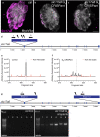How Zebrafish Can Drive the Future of Genetic-based Hearing and Balance Research
- PMID: 33909162
- PMCID: PMC8110678
- DOI: 10.1007/s10162-021-00798-z
How Zebrafish Can Drive the Future of Genetic-based Hearing and Balance Research
Abstract
Over the last several decades, studies in humans and animal models have successfully identified numerous molecules required for hearing and balance. Many of these studies relied on unbiased forward genetic screens based on behavior or morphology to identify these molecules. Alongside forward genetic screens, reverse genetics has further driven the exploration of candidate molecules. This review provides an overview of the genetic studies that have established zebrafish as a genetic model for hearing and balance research. Further, we discuss how the unique advantages of zebrafish can be leveraged in future genetic studies. We explore strategies to design novel forward genetic screens based on morphological alterations using transgenic lines or behavioral changes following mechanical or acoustic damage. We also outline how recent advances in CRISPR-Cas9 can be applied to perform reverse genetic screens to validate large sequencing datasets. Overall, this review describes how future genetic studies in zebrafish can continue to advance our understanding of inherited and acquired hearing and balance disorders.
Keywords: genetic screening; genetics; hearing and balance; zebrafish.
Conflict of interest statement
The authors declare no competing interests.
Figures







Similar articles
-
The genetics of hearing and balance in zebrafish.Annu Rev Genet. 2005;39:9-22. doi: 10.1146/annurev.genet.39.073003.105049. Annu Rev Genet. 2005. PMID: 16285850 Review.
-
The role of ear stone size in hair cell acoustic sensory transduction.Sci Rep. 2013;3:2114. doi: 10.1038/srep02114. Sci Rep. 2013. PMID: 23817603 Free PMC article.
-
Early development of hearing in zebrafish.J Assoc Res Otolaryngol. 2013 Aug;14(4):509-21. doi: 10.1007/s10162-013-0386-z. Epub 2013 Apr 11. J Assoc Res Otolaryngol. 2013. PMID: 23575600 Free PMC article.
-
The transmembrane inner ear (Tmie) protein is essential for normal hearing and balance in the zebrafish.Proc Natl Acad Sci U S A. 2009 Dec 15;106(50):21347-52. doi: 10.1073/pnas.0911632106. Epub 2009 Nov 23. Proc Natl Acad Sci U S A. 2009. PMID: 19934034 Free PMC article.
-
Zebrafish as a model for hearing and deafness.J Neurobiol. 2002 Nov 5;53(2):157-71. doi: 10.1002/neu.10123. J Neurobiol. 2002. PMID: 12382273 Review.
Cited by
-
Presynaptic Nrxn3 is essential for ribbon-synapse maturation in hair cells.Development. 2024 Oct 1;151(19):dev202723. doi: 10.1242/dev.202723. Epub 2024 Oct 10. Development. 2024. PMID: 39254120 Free PMC article.
-
The role of ATP-binding Cassette subfamily B member 6 in the inner ear.Nat Commun. 2024 Nov 18;15(1):9885. doi: 10.1038/s41467-024-53663-x. Nat Commun. 2024. PMID: 39557842 Free PMC article.
-
Preclinical Models to Study the Molecular Pathophysiology of Meniere's Disease: A Pathway to Gene Therapy.J Clin Med. 2025 Feb 20;14(5):1427. doi: 10.3390/jcm14051427. J Clin Med. 2025. PMID: 40094841 Free PMC article.
-
Presynaptic Nrxn3 is essential for ribbon-synapse assembly in hair cells.bioRxiv [Preprint]. 2024 Feb 15:2024.02.14.580267. doi: 10.1101/2024.02.14.580267. bioRxiv. 2024. Update in: Development. 2024 Oct 1;151(19):dev202723. doi: 10.1242/dev.202723. PMID: 38410471 Free PMC article. Updated. Preprint.
-
Kif1a and intact microtubules maintain synaptic-vesicle populations at ribbon synapses in zebrafish hair cells.bioRxiv [Preprint]. 2024 May 20:2024.05.20.595037. doi: 10.1101/2024.05.20.595037. bioRxiv. 2024. Update in: J Physiol. 2024 Oct 7. doi: 10.1113/JP286263. PMID: 38903095 Free PMC article. Updated. Preprint.
References
-
- Aman A, Nguyen M, Piotrowski T. Wnt/β-catenin dependent cell proliferation underlies segmented lateral line morphogenesis. Dev Biol. 2011;349:470–482. - PubMed
Publication types
MeSH terms
Grants and funding
LinkOut - more resources
Full Text Sources
Other Literature Sources

